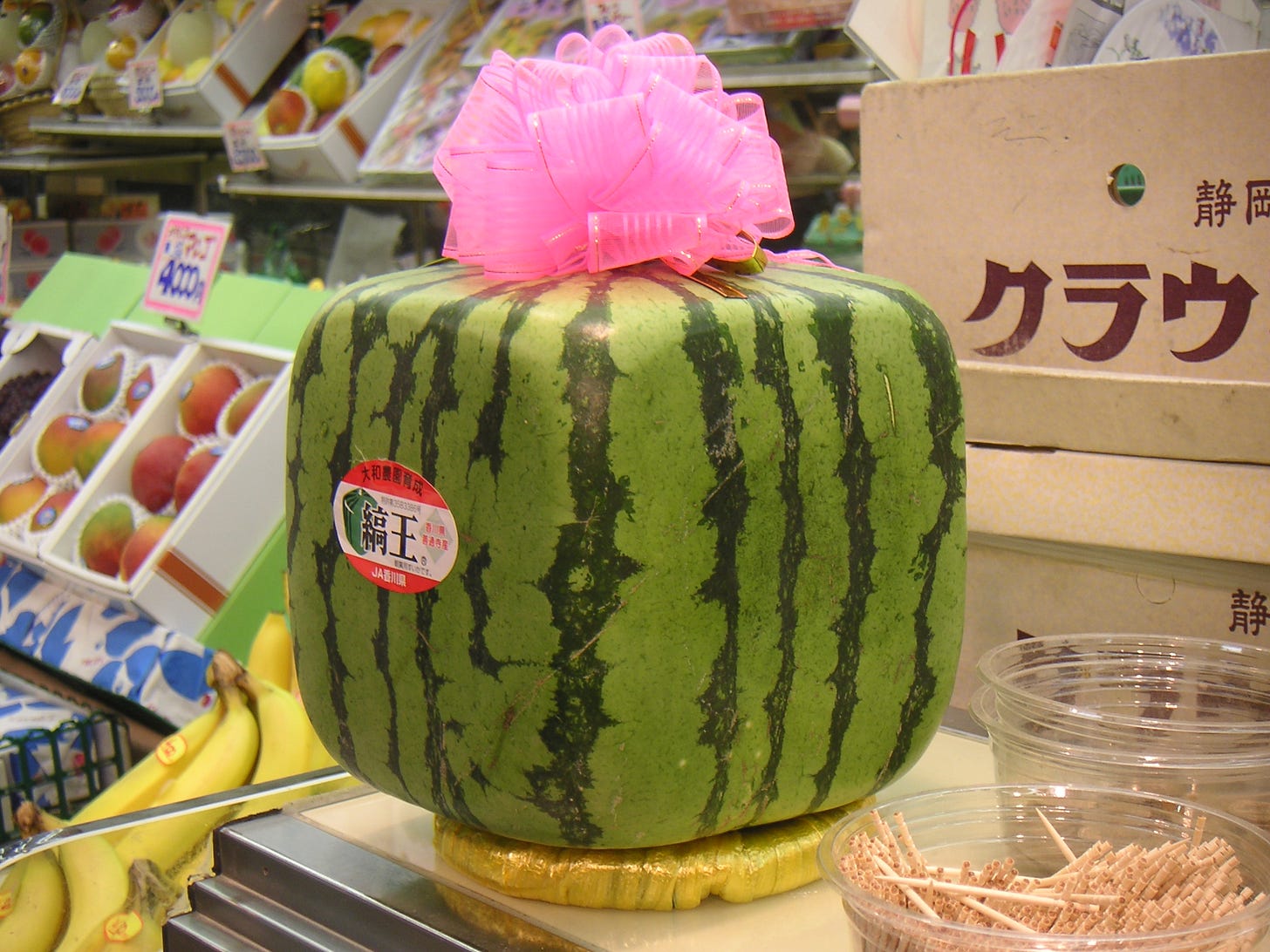Form: Natural and Artificial: Watermelon
At Home with the Glynns: Chapter 35:
“Now answer this if you can: What shape is a watermelon?”
Almost without thinking, I moved my hands into position to hold a nonexistent watermelon. “Well—” I said.
“I mean exactly what shape is a watermelon?” said Andy.
I hefted the watermelon.
“Well—”
“You can’t say, can you?”
“I—”
“And yet you must know, because when you see something that approximates that shape, then you say to yourself: that’s a lot like a watermelon—in fact, that is a watermelon.”
I looked at the empty space between my hands and said, “Mm.” […]
“Voilà!” he said, plucking off the shroud.
There it was: the watermelon, lying there cool and green and striped, the perfect treat for a languid August afternoon, for the languid August afternoon.
“What shape is a watermelon?” is not a question for which there is a single answer, or even a general answer. Consider this:
Wikipedia, “Square watermelon”:
Square or cube watermelons are watermelons grown into the shape of a cube. Cube watermelons are commonly sold in Japan, where they are essentially ornamental and are often very expensive, with prices as high as US$200.
Cube watermelons were intended to fit more compactly in fridges and their shape makes them easier to cut as they don’t roll. They were invented by graphic designer Tomoyuki Ono in 1978. He presented the watermelons in a gallery in Ginza, Tokyo. He also applied for and received a patent in the United States.
The melons are grown in boxes and take the shape of the container, and they tend to appeal to wealthy or fashionable consumers. […]
Although cube melons were originally created with practicality in mind, the cost is prohibitive. The cube shape of the watermelon can only be achieved at the expense of its contents. To retain the proper shape, cube melons must be harvested before they are ripe, rendering them inedible.
Since the advent of the cube watermelon, other watermelon shapes have been introduced, such as hearts and pyramids. They are also available in other countries now, such as in Germany.

See also:
Form TG 467; Form (in Life, Art, Cookery): Hodgepodge TG 746
Have you missed an episode or two or several?
You can begin reading at the beginning or you can catch up by visiting the archive or consulting the index to the Topical Guide. The Substack serialization of Little Follies begins here; Herb ’n’ Lorna begins here; Reservations Recommended begins here; Where Do You Stop? begins here; What a Piece of Work I Am begins here; At Home with the Glynns begins here.
You can listen to the episodes on the Personal History podcast. Begin at the beginning or scroll through the episodes to find what you’ve missed. The Substack podcast reading of Little Follies begins here; Herb ’n’ Lorna begins here; Reservations Recommended begins here; Where Do You Stop? begins here; What a Piece of Work I Am begins here; At Home with the Glynns begins here.
You can listen to “My Mother Takes a Tumble” and “Do Clams Bite?” complete and uninterrupted as audiobooks through YouTube.
You can ensure that you never miss a future issue by getting a free subscription. (You can help support the work by choosing a paid subscription instead.)
At Apple Books you can download free eBooks of Little Follies, Herb ’n’ Lorna, Reservations Recommended, and Where Do You Stop? and What a Piece of Work I Am.
You’ll find overviews of the entire work in An Introduction to The Personal History, Adventures, Experiences & Observations of Peter Leroy (a pdf document), The Origin Story (here on substack), Between the Lines (a video, here on Substack), and at Encyclopedia.com.


